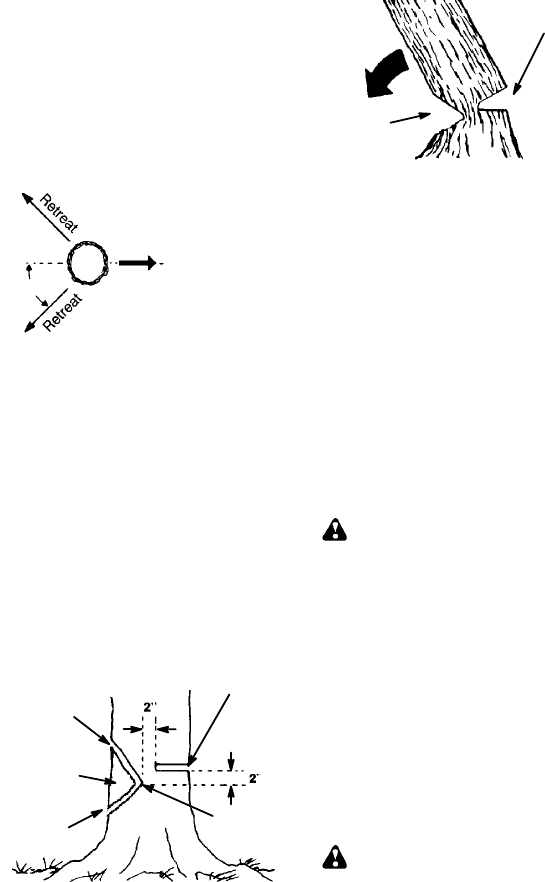
12
S The wind direction and speed.
S The lean of the tree. The lean of a tree
might not be apparent due to uneven or
slopingterrain. Useaplumborleveltode-
termine the direction of tree lean.
S Weight and branches on one side.
S Surrounding trees and obstacles.
Look for decay and rot. Ifthetrunk isrotted,
it can snap and fall toward the operator.
Check for broken or dead branches which
can fall on you while cutting.
Make sure there i s enoughroom for t he t reeto
fall. Maintain a distance of
2-1/2 tree le ngths
from the nearest person or other objects. En-
gine noise can drown out a warning call.
Remove dirt, stones, loose bark, nails, sta-
ples,andwirefromthetreewherecutsaret o
bemade.Planaclearretreatpathtotherear
and diagonal tothe line of fall.
Direction of Fall
45_
Plan a clearretreat path
FELLING LARGE TREES
(6 inches (15 cm) in diameter or larger)
The not chmethod is usedto felllarge trees.
Anotchiscutonthesideofthetreei nt hede-
sired direction of fall. After a felling cut is
made on the opposite side of tree, the tree
will tend to fallinto the notch.
NOTE: If thetree haslarge buttress roots,
removethembeforemakingthenotch. Ifus-
ing sawto remove buttress roots, keep saw
chainfromcontactinggroundtopreventdull-
ing of thechain.
NOTCH CUT AND FELLING THE
TREE
S Make notch cut by cutting the top of the
notch first. Cutthrough
1/3of thediameter
ofthetree.Nextcompletethenotchbycut-
ting the bottom of the notch. See illustra-
tion. Once the notch is cut remove the
notch of wood from the tree.
Notch
First cut
Second cut
Final (felling) cut here, 2 inches
(5 cm) above center of notch.
Hinge
S After removing t he wood f rom the not ch,
make the felling cut on the opposite side of
thenotch.Thisisdonebymakingacutabout
two inches (5 cm) higher than the center of
thenotch.Thiswill l eaveenoughuncutwood
between thefelling cutand t he not ch toform
a h inge. This hingewill h elpprevent thetree
from falling in the wrong direction.
Opening
of felling
cut
Closing of
notch
Hinge holdstree on stump and helps
control fall
NOTE: Before felling cut is complete, use
wedges to open the cut if necessary to
controlthedir ectionoffall. Toavoidkickback
and chain damage, use wood o r plastic
wedges, but never steel or iron wedges.
S Be alert to signs that the tree is ready to
fall: cracking sounds, widening of the fell-
ing cut, or movement in the upper
branches.
S As treestartsto fall,stopsaw ,putit down,
and get away quickly on your planned r e-
treat path.
S DO NOT cut down a partially fallen tree
withyour saw. Beextremelycautiouswith
partially fallen trees that may be poorly
supported. When a tree doesn’t fall com-
pletely,setthesawasideandpulldownthe
tree with a cable winch, block and tackle,
or tractor.
CUTTING A FALLEN TREE
(BUCKING)
Bucking is the term used for cutting a fallen
tree to the desired log size.
WARNING: Donotstandonthelog
being cut. Anyportion can r oll causing loss
of f ootingand control. Donot standdownhill
of the logbeing cut.
IMPORTANT POINTS
S Cut only one logat a time.
S Cut shattered wood very carefully; sharp
pieces of woodcould beflung towardopera-
tor .
S Use a sawhorse to cut small logs. Never
allow another person to holdthe log w hile
cuttingandneverholdthelogwithyourleg
or foot.
S Do not cut in an area where logs, limbs,
and roots are tangled such as in a blown
downarea. Dragthe logsintoacleararea
before cutting by pulling out exposed and
cleared logs first.
TYPES OF CUTTING USED FOR
BUCKING
WARNING: If s aw becomes
pinched or hung in alog, don’t try to force it
out. Youcanlosecontrolofthesawresulting
ininjury and/ordamagetothesaw. Stopthe
saw,driveawedgeofplasticorw oodintothe
cutuntilthesaw canb eremovedeasily. Re-


















